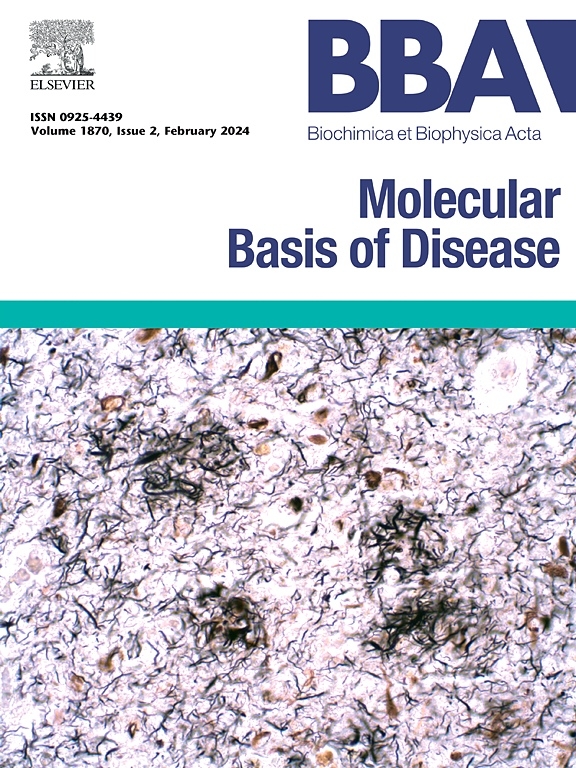FOXO1-driven endothelial senescence in bicuspid aortic valve-associated thoracic aortic aneurysm
IF 4.2
2区 生物学
Q2 BIOCHEMISTRY & MOLECULAR BIOLOGY
Biochimica et biophysica acta. Molecular basis of disease
Pub Date : 2025-09-17
DOI:10.1016/j.bbadis.2025.168052
引用次数: 0
Abstract
Bicuspid aortic valve (BAV) is a congenital malformation that predisposes individuals to thoracic aortic aneurysm (TAA), with endothelial dysfunction playing a pivotal role in its pathogenesis. Endothelial cell senescence is a hallmark of endothelial dysfunction, yet direct evidence linking endothelial senescence to BAV-TAA has not been established. In this study, we generated induced pluripotent stem cells (iPSCs) from both BAV-TAA patients and healthy controls, subsequently differentiating them into endothelial cells (iECs). Our findings revealed that BAV-TAA-iECs exhibited senescence phenotype, including impaired proliferation, diminished migratory capacity, upregulated senescence markers (p53, p21, p16), and a pronounced senescence-associated secretory phenotype (SASP). Transcriptomic analysis through RNA sequencing indicated aberrant activation of the FOXO signaling pathway in BAV-TAA-iECs which might contribute to BAV-TAA-iEC senescence. Inhibition of FOXO1 signaling using AS1842856 effectively reversed the senescence phenotype, restored endothelial nitric oxide synthase (eNOS) expression, attenuated SASP cytokine levels, and mitigated inflammation through the p65 and p38 signaling pathways. These findings suggest that endothelial cell senescence plays a critical role in the pathogenesis of BAV-TAA, and targeting FOXO1 signaling may represent a promising therapeutic strategy for BAV-associated aortic diseases.
fox01驱动的二尖瓣主动脉瓣相关性胸主动脉瘤内皮细胞衰老。
双尖瓣主动脉瓣(BAV)是一种先天性畸形,使个体易患胸主动脉瘤(TAA),内皮功能障碍在其发病机制中起关键作用。内皮细胞衰老是内皮功能障碍的标志,但内皮细胞衰老与baw - taa之间的直接证据尚未建立。在这项研究中,我们从BAV-TAA患者和健康对照中获得了诱导多能干细胞(iPSCs),随后将其分化为内皮细胞(iECs)。我们的研究结果显示,baw - taa - iecs表现出衰老表型,包括增殖受损、迁移能力减弱、衰老标志物(p53、p21、p16)上调以及明显的衰老相关分泌表型(SASP)。通过RNA测序的转录组学分析表明,baw - taa - iec中FOXO信号通路的异常激活可能导致baw - taa - iec衰老。利用AS1842856抑制FOXO1信号通路,可有效逆转衰老表型,恢复内皮型一氧化氮合酶(eNOS)表达,降低SASP细胞因子水平,并通过p65和p38信号通路减轻炎症。这些发现表明,内皮细胞衰老在baw - taa的发病机制中起着关键作用,靶向FOXO1信号通路可能是baw相关主动脉疾病的一种有希望的治疗策略。
本文章由计算机程序翻译,如有差异,请以英文原文为准。
求助全文
约1分钟内获得全文
求助全文
来源期刊
CiteScore
12.30
自引率
0.00%
发文量
218
审稿时长
32 days
期刊介绍:
BBA Molecular Basis of Disease addresses the biochemistry and molecular genetics of disease processes and models of human disease. This journal covers aspects of aging, cancer, metabolic-, neurological-, and immunological-based disease. Manuscripts focused on using animal models to elucidate biochemical and mechanistic insight in each of these conditions, are particularly encouraged. Manuscripts should emphasize the underlying mechanisms of disease pathways and provide novel contributions to the understanding and/or treatment of these disorders. Highly descriptive and method development submissions may be declined without full review. The submission of uninvited reviews to BBA - Molecular Basis of Disease is strongly discouraged, and any such uninvited review should be accompanied by a coverletter outlining the compelling reasons why the review should be considered.

 求助内容:
求助内容: 应助结果提醒方式:
应助结果提醒方式:


